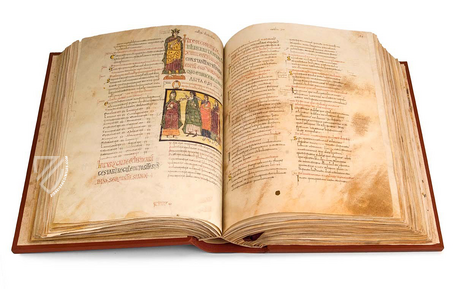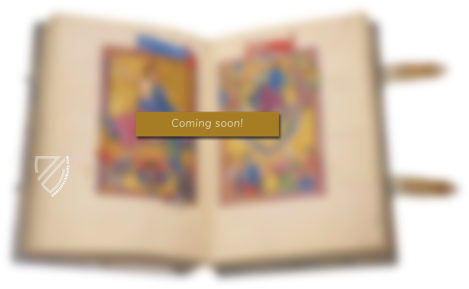Aelfric’s First Series of Catholic Homilies
(under 1,000€)
Ælfric of Eynsham was an abbot in Anglo-Saxon England who was a prolific author of Old English homilies, hagiographies, and commentaries on the Bible who was also highly influential in shaping monastic reform during the 10th century. Created ca. 990–995, the Sermones Catholici are his earliest known works and are Old English translations of Latin texts that draw on the gospels, saints' lives´, and other doctrinal themes. Ælfric’s First Series of Catholic Homilies consists of 40 homilies devoted to the chief events of the liturgical year and is, according to the author’s own Latin preface, intended “for the edification of the simple” – the laity. Aside from holding the earliest known copy of the work, other texts in the manuscript include fragments of Canon Tables from a 7th or 8th century Gospel Book and extracts from Gesta Francorum by Gregory of Tours, Sermo de Sabbato Pasche, Gospel of Nicodemus, and fragments of Expositio Psalmorum by Cassiodorus Senator.
Aelfric’s First Series of Catholic Homilies
Ælfric of Eynsham (ca. 955 – ca. 1010), also known as Ælfric the Grammarian, Ælfric of Cerne, and Ælfric the Homilist, was a theologian and writer whose works and intellect have been compared with Saint Bede and who represented the pinnacle of both Anglo-Saxon literature and the Benedictine reform movement in England. In the Latin preface to his first series of Catholic homilies, Ælfric lists the various authors whose works he consulted, first and foremost Gregory the Great. He goes on to lament the lack of access Englishmen have to the teachings of the Church Fathers.
The forty homilies are devoted to the principal events of the liturgical year and are divided into three parts: fragments of canon tables from a 7th or 8th century Gospel Book, a copy of Aelfric’s first series of Old English homilies from the turn of the 11th century, and extracts from Gregory of Tours, Gesta Francorum, Sermo de Sabbato Pasche, the Gospel of Nicodemus, and fragments of Cassiodorus Senator’s Expositio Psalmorum. Decorative initials, zoomorphic ornaments, and rubrics adorn the text. The coveted manuscript was once owned by Thomas Wolsey (1473–1530), the distinguished English statesman and Archbishop of York under King Henry VIII.
The Life of Ælfric
Previously confused with Ælfric of Abingdon, the Archbishop of Canterbury, Ælfric of Eynsham was an abbot who was educated in the Benedictine Old Minster at Winchester under Saint Æthelwold of Winchester, who reigned there as bishop during the years 963–984. He carried on the reforms of Saint Dunstan to monastic life in his governance of the abbeys at Abingdon, Berkshire, and Winchester. It was in Winchester that he began to build his reputation as a scholar and when Cerne Abbey was founded in 987, he was sent by Bishop Ælfheah at the request of its chief benefactor, the ealdorman Æthelmær the Stout, to instruct the Benedictine monks there. Ælfric created two series of English homilies while at Cerne, which were dedicated to Archbishop Sigeric of Canterbury, the first of which is presented here. He appears to have split his time between Cerne and Winchester before the year 1005, when he set out for the newly founded Eynsham Abbey, where he became its first abbot and lived there for the rest of his life.
Ælfric’s Teachings and Works
Remembered as the most prolific Old English author, the main theme of Ælfric’s writings is God’s mercy, but he also expressed some progressive views toward women. The early English Church did not abide by the Roman doctrine of transubstantiation and Ælfric did not believe in the Immaculate Conception. He also made significant contributions to the instruction of Latin in England: his Grammar is regarded as the first vernacular translation of Latin grammar in medieval Europe, his Glossary was not organized alphabetically but thematically, and his Colloquy was a conversational manual for Latin students. He went on to create a third, hagiographic series of homilies, and an Old English translation of selections from the Haxateuch. After becoming abbot of Eynsham, he wrote his Letter to the Monks of Eynsham concerning monastic life, a vita of his old master Æthelwold, an introduction for the study of the Bible, an English translation of Bede’s De Temporibus, and various letters to contemporary scholars.
Codicology
- Alternative Titles
- Aelfrics erste Reihe katholischer Homilien
- Size / Format
- 462 pages / 31.0 × 21.0 cm
- Origin
- United Kingdom
- Date
- 7th or 8th century, late 10th century, and 12th century
- Epochs
- Style
- Genre
- Script
- Anglo-Saxon minusclue
- Illustrations
- Decorated initials
- Content
- Fragments of canon tables; the First Series of Catholic Homilies by Ælfric of Eynsham, extracts from exegetical and historical texts
- Artist / School
- Ælfric of Eynsham (scribe and author)
and seven other hands - Previous Owners
- Thomas Wolsey
Robert Beale
English Royal Library
British Museum
#1 Aelfric’s First Series of Catholic Homilies
Language: English
(under 1,000€)
- Treatises / Secular Books
- Apocalypses / Beatus
- Astronomy / Astrology
- Bestiaries
- Bibles / Gospels
- Chronicles / History / Law
- Geography / Maps
- Saints' Lives
- Islam / Oriental
- Judaism / Hebrew
- Single Leaf Collections
- Leonardo da Vinci
- Literature / Poetry
- Liturgical Manuscripts
- Medicine / Botany / Alchemy
- Music
- Mythology / Prophecies
- Psalters
- Other Religious Books
- Games / Hunting
- Private Devotion Books
- Other Genres
- Afghanistan
- Armenia
- Austria
- Belgium
- Belize
- Bosnia and Herzegovina
- China
- Colombia
- Costa Rica
- Croatia
- Cyprus
- Czech Republic
- Denmark
- Egypt
- El Salvador
- Ethiopia
- France
- Germany
- Greece
- Guatemala
- Honduras
- Hungary
- India
- Iran
- Iraq
- Israel
- Italy
- Japan
- Jordan
- Kazakhstan
- Kyrgyzstan
- Lebanon
- Liechtenstein
- Luxembourg
- Mexico
- Morocco
- Netherlands
- Palestine
- Panama
- Peru
- Poland
- Portugal
- Romania
- Russia
- Serbia
- Spain
- Sri Lanka
- Sweden
- Switzerland
- Syria
- Tajikistan
- Turkey
- Turkmenistan
- Ukraine
- United Kingdom
- United States
- Uzbekistan
- Vatican City
- A. Oosthoek, van Holkema & Warendorf
- Aboca Museum
- Ajuntament de Valencia
- Akademie Verlag
- Akademische Druck- u. Verlagsanstalt (ADEVA)
- Aldo Ausilio Editore - Bottega d’Erasmo
- Alecto Historical Editions
- Alkuin Verlag
- Almqvist & Wiksell
- Amilcare Pizzi
- Andreas & Andreas Verlagsbuchhandlung
- Archa 90
- Archiv Verlag
- Archivi Edizioni
- Arnold Verlag
- ARS
- Ars Magna
- ArtCodex
- AyN Ediciones
- Azimuth Editions
- Badenia Verlag
- Bärenreiter-Verlag
- Belser Verlag
- Belser Verlag / WK Wertkontor
- Benziger Verlag
- Bernardinum Wydawnictwo
- BiblioGemma
- Biblioteca Apostolica Vaticana (Vaticanstadt, Vaticanstadt)
- Bibliotheca Palatina Faksimile Verlag
- Bibliotheca Rara
- Boydell & Brewer
- Bramante Edizioni
- Bredius Genootschap
- Brepols Publishers
- British Library
- C. Weckesser
- Caixa Catalunya
- Canesi
- CAPSA, Ars Scriptoria
- Caratzas Brothers, Publishers
- Carus Verlag
- Casamassima Libri
- Centrum Cartographie Verlag GmbH
- Chavane Verlag
- Christian Brandstätter Verlag
- Circulo Cientifico
- Club Bibliófilo Versol
- Club du Livre
- CM Editores
- Collegium Graphicum
- Collezione Apocrifa Da Vinci
- Comissão Nacional para as Comemorações dos Descobrimentos Portugueses
- Coron Verlag
- Corvina
- CTHS
- D. S. Brewer
- Damon
- De Agostini/UTET
- De Nederlandsche Boekhandel
- De Schutter
- Deuschle & Stemmle
- Deutscher Verlag für Kunstwissenschaft
- DIAMM
- Droz
- E. Schreiber Graphische Kunstanstalten
- Ediciones Boreal
- Ediciones Grial
- Ediclube
- Edições Inapa
- Edilan
- Editalia
- Edition Deuschle
- Edition Georg Popp
- Edition Leipzig
- Edition Libri Illustri
- Editiones Reales Sitios S. L.
- Éditions de l'Oiseau Lyre
- Editions Medicina Rara
- Editorial Casariego
- Editorial Mintzoa
- Editrice Antenore
- Editrice Velar
- Edizioni Edison
- Egeria, S.L.
- Eikon Editores
- Electa
- Emery Walker Limited
- Enciclopèdia Catalana
- Eos-Verlag
- Ephesus Publishing
- Ernst Battenberg
- Eugrammia Press
- Extraordinary Editions
- Fackelverlag
- Facsimila Art & Edition
- Facsimile Editions Ltd.
- Facsimilia Art & Edition Ebert KG
- Faksimile Verlag
- Feuermann Verlag
- Folger Shakespeare Library
- Franco Cosimo Panini Editore
- Friedrich Wittig Verlag
- Fundación Hullera Vasco-Leonesa
- G. Braziller
- Gabriele Mazzotta Editore
- Gebr. Mann Verlag
- Gesellschaft für graphische Industrie
- Getty Research Institute
- Giovanni Domenico de Rossi
- Giunti Editore
- Graffiti
- Grafica European Center of Fine Arts
- Guido Pressler
- Guillermo Blazquez
- Gustav Kiepenheuer
- H. N. Abrams
- Harrassowitz
- Harvard University Press
- Helikon
- Hendrickson Publishers
- Henning Oppermann
- Herder Verlag
- Hes & De Graaf Publishers
- Hoepli
- Holbein-Verlag
- Houghton Library
- Hugo Schmidt Verlag
- Idion Verlag
- Il Bulino, edizioni d'arte
- ILte
- Imago
- Insel Verlag
- Insel-Verlag Anton Kippenberger
- Instituto de Estudios Altoaragoneses
- Instituto Nacional de Antropología e Historia
- Introligatornia Budnik Jerzy
- Istituto dell'Enciclopedia Italiana - Treccani
- Istituto Ellenico di Studi Bizantini e Postbizantini
- Istituto Geografico De Agostini
- Istituto Poligrafico e Zecca dello Stato
- Italarte Art Establishments
- Jan Thorbecke Verlag
- Johnson Reprint Corporation
- Josef Stocker
- Josef Stocker-Schmid
- Jugoslavija
- Karl W. Hiersemann
- Kasper Straube
- Kaydeda Ediciones
- Kindler Verlag / Coron Verlag
- Kodansha International Ltd.
- Konrad Kölbl Verlag
- Kurt Wolff Verlag
- La Liberia dello Stato
- La Linea Editrice
- La Meta Editore
- Lambert Schneider
- Landeskreditbank Baden-Württemberg
- Leo S. Olschki
- Les Incunables
- Liber Artis
- Library of Congress
- Libreria Musicale Italiana
- Lichtdruck
- Lito Immagine Editore
- Lumen Artis
- Lund Humphries
- M. Moleiro Editor
- Maison des Sciences de l'homme et de la société de Poitiers
- Manuscriptum
- Martinus Nijhoff
- Maruzen-Yushodo Co. Ltd.
- MASA
- Massada Publishers
- McGraw-Hill
- Metropolitan Museum of Art
- Militos
- Millennium Liber
- Müller & Schindler
- Nahar - Stavit
- Nahar and Steimatzky
- National Library of Wales
- Neri Pozza
- Nova Charta
- Oceanum Verlag
- Odeon
- Orbis Mediaevalis
- Orbis Pictus
- Österreichische Staatsdruckerei
- Oxford University Press
- Pageant Books
- Parzellers Buchverlag
- Patrimonio Ediciones
- Pattloch Verlag
- PIAF
- Pieper Verlag
- Plon-Nourrit et cie
- Poligrafiche Bolis
- Presses Universitaires de Strasbourg
- Prestel Verlag
- Princeton University Press
- Prisma Verlag
- Priuli & Verlucca, editori
- Pro Sport Verlag
- Propyläen Verlag
- Pytheas Books
- Quaternio Verlag Luzern
- Reales Sitios
- Recht-Verlag
- Reichert Verlag
- Reichsdruckerei
- Reprint Verlag
- Riehn & Reusch
- Roberto Vattori Editore
- Rosenkilde and Bagger
- Roxburghe Club
- Salerno Editrice
- Saltellus Press
- Sandoz
- Sarajevo Svjetlost
- Schöck ArtPrint Kft.
- Schulsinger Brothers
- Scolar Press
- Scrinium
- Scripta Maneant
- Scriptorium
- Shazar
- Siloé, arte y bibliofilia
- SISMEL - Edizioni del Galluzzo
- Sociedad Mexicana de Antropología
- Société des Bibliophiles & Iconophiles de Belgique
- Soncin Publishing
- Sorli Ediciones
- Stainer and Bell
- Studer
- Styria Verlag
- Sumptibus Pragopress
- Szegedi Tudomànyegyetem
- Taberna Libraria
- Tarshish Books
- Taschen
- Tempus Libri
- Testimonio Compañía Editorial
- Thames and Hudson
- The Clear Vue Publishing Partnership Limited
- The Facsimile Codex
- The Folio Society
- The Marquess of Normanby
- The Richard III and Yorkist History Trust
- Tip.Le.Co
- TouchArt
- TREC Publishing House
- TRI Publishing Co.
- Trident Editore
- Tuliba Collection
- Typis Regiae Officinae Polygraphicae
- Union Verlag Berlin
- Universidad de Granada
- University of California Press
- University of Chicago Press
- Urs Graf
- Vallecchi
- Van Wijnen
- VCH, Acta Humaniora
- VDI Verlag
- VEB Deutscher Verlag für Musik
- Verlag Anton Pustet / Andreas Verlag
- Verlag Bibliophile Drucke Josef Stocker
- Verlag der Münchner Drucke
- Verlag für Regionalgeschichte
- Verlag Styria
- Vicent Garcia Editores
- W. Turnowski Ltd.
- W. Turnowsky
- Waanders Printers
- Wiener Mechitharisten-Congregation (Wien, Österreich)
- Wissenschaftliche Buchgesellschaft
- Wissenschaftliche Verlagsgesellschaft
- Wydawnictwo Dolnoslaskie
- Xuntanza Editorial
- Zakład Narodowy
- Zollikofer AG









